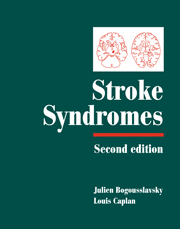Book contents
- Frontmatter
- Contents
- List of contributors
- Preface
- PART I CLINICAL MANIFESTATIONS
- PART II VASCULAR TOPOGRAPHIC SYNDROMES
- 29 Arterial territories of human brain
- 30 Superficial middle cerebral artery syndromes
- 31 Lenticulostriate arteries
- 32 Anterior cerebral artery
- 33 Anterior choroidal artery territory infarcts
- 34 Thalamic infarcts and hemorrhages
- 35 Caudate infarcts and hemorrhages
- 36 Posterior cerebral artery
- 37 Large and panhemispheric infarcts
- 38 Multiple, multilevel and bihemispheric infarcts
- 39 Midbrain infarcts
- 40 Pontine infarcts and hemorrhages
- 41 Medullary infarcts and hemorrhages
- 42 Cerebellar stroke syndromes
- 43 Extended infarcts in the posterior circulation (brainstem/cerebellum)
- 44 Border zone infarcts
- 45 Classical lacunar syndromes
- 46 Putaminal hemorrhages
- 47 Lobar hemorrhages
- 48 Intraventricular hemorrhages
- 49 Subarachnoid hemorrhage syndromes
- 50 Brain venous thrombosis syndromes
- 51 Carotid occlusion syndromes
- 52 Cervical artery dissection syndromes
- 53 Syndromes related to large artery thromboembolism within the vertebrobasilar system
- 54 Spinal stroke syndromes
- Index
- Plate section
46 - Putaminal hemorrhages
from PART II - VASCULAR TOPOGRAPHIC SYNDROMES
Published online by Cambridge University Press: 17 May 2010
- Frontmatter
- Contents
- List of contributors
- Preface
- PART I CLINICAL MANIFESTATIONS
- PART II VASCULAR TOPOGRAPHIC SYNDROMES
- 29 Arterial territories of human brain
- 30 Superficial middle cerebral artery syndromes
- 31 Lenticulostriate arteries
- 32 Anterior cerebral artery
- 33 Anterior choroidal artery territory infarcts
- 34 Thalamic infarcts and hemorrhages
- 35 Caudate infarcts and hemorrhages
- 36 Posterior cerebral artery
- 37 Large and panhemispheric infarcts
- 38 Multiple, multilevel and bihemispheric infarcts
- 39 Midbrain infarcts
- 40 Pontine infarcts and hemorrhages
- 41 Medullary infarcts and hemorrhages
- 42 Cerebellar stroke syndromes
- 43 Extended infarcts in the posterior circulation (brainstem/cerebellum)
- 44 Border zone infarcts
- 45 Classical lacunar syndromes
- 46 Putaminal hemorrhages
- 47 Lobar hemorrhages
- 48 Intraventricular hemorrhages
- 49 Subarachnoid hemorrhage syndromes
- 50 Brain venous thrombosis syndromes
- 51 Carotid occlusion syndromes
- 52 Cervical artery dissection syndromes
- 53 Syndromes related to large artery thromboembolism within the vertebrobasilar system
- 54 Spinal stroke syndromes
- Index
- Plate section
Summary
Changing clinical features of putaminal Hemorrhages
Before computed tomography (CT) became a routine examination for stroke patients, primary brain hemorrhage (PBH) was considered to entail extremely high morbidity and mortality. The reported incidences of PBH have varied in a number of studies, but its clinical severity has consistently been decreasing since the advent of CT has allowed earlier detection (Hier et al., 1977; Drury et al. 1984; Kutsuzawa, 1987; Ueda et al., 1988; Broderick et al., 1989). A population study in Rochester, Minnesota documented a dramatic decrease in the 30-day mortality rate among patients with PBH, from approximately 90% in 1945–74 to less than 50% in 1980–4 (Broderick et al., 1989). Kutsuzawa (1987) studied 1247 patients with PBH and found that the 30-day mortality rate declined from 23.9% in 1969–76 to 13.4% in 1982–6. The decrease in mortality from PBH reported in those studies coincided with the introduction of CT scanning, indicating that smaller hemorrhages were more frequently being identified by CT. Drury et al. (1984) estimated that 24% of patients with PBH were misdiagnosed as having brain infarction before the CT era. In addition, a decrease in the incidence of hypertension and improvements in antihypertensive therapy may have contributed to the reduced severity of PBH, because the trend has continued since the CT era began (Ueda et al., 1988; Schütz et al., 1992).
The putamen is located deep inside the brain and is surrounded by the internal and external capsules and the corona radiata.
- Type
- Chapter
- Information
- Stroke Syndromes , pp. 590 - 598Publisher: Cambridge University PressPrint publication year: 2001
- 1
- Cited by



